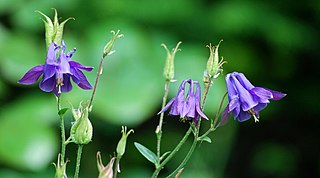
Aquilegia is a genus of about 130 species of perennial plants that are found in meadows, woodlands, and at higher elevations throughout the Northern Hemisphere, known for the spurred petals of their flowers.

Aquilegia formosa, the crimson columbine, western columbine, or (ambiguously) "red columbine", is a common wildflower native to western North America, from Alaska to Baja California, and eastward to Montana and Wyoming.

Aquilegia canadensis, the Canadian or Canada columbine, eastern red columbine, or wild columbine, is a species of flowering plant in the buttercup family Ranunculaceae. It is an herbaceous perennial native to woodland and rocky slopes in eastern North America, prized for its red and yellow flowers. It readily hybridizes with other species in the genus Aquilegia.
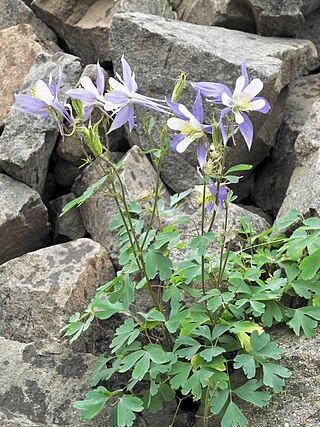
Aquilegia coerulea, the Colorado columbine, Rocky Mountain columbine, or blue columbine, is a species of flowering plant in the buttercup family Ranunculaceae, native to the Rocky Mountains and some of the surrounding states of the western United States. It is the state flower of Colorado. The Latin specific name coerulea means "sky blue".

Aquilegia barbaricina, common name Barbaricina columbine, is a perennial species of flowering plant in the family Ranunculaceae. It is endemic to Italy, occurring only on the island of Sardinia.

Aquilegia chrysantha, the golden columbine, is a perennial herbaceous flowering plant native to the southwestern United States and northwestern Mexico.

The Grigna is a mountain massif in the province of Lecco, Lombardy, northern Italy, with an elevation of 2,410 metres (7,907 ft). It is part of the Bergamo Alps, and it has two peaks, Grignone or Grigna settentrionale(2,410m), the higher Northern, and the lower, Southern Grignetta or Grigna meridionale (2,184 m).
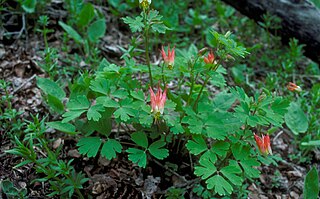
Aquilegia elegantula, the western red columbine, is a perennial species of plant in the family Ranunculaceae, native to the Southwestern United States and northern Mexico.
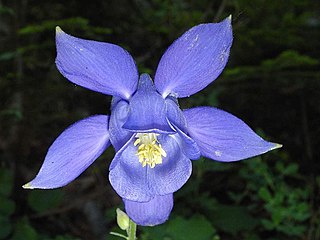
Aquilegia bertolonii, common name Bertoloni columbine or Bertoloni's columbine, is a perennial species of flowering plant in the family Ranunculaceae, native to Italy, southern France, and Slovenia.

Aquilegia atrata, the dark columbine, is a perennial species of flowering plant in the family Ranunculaceae, native to the Alps and Apennine Mountains.
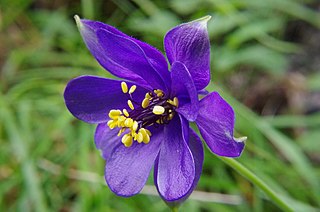
Aquilegia alpina, the alpine columbine or breath of God, is a perennial species of flowering plant in the family Ranunculaceae, native to the western and central Alps.

Aquilegia ecalcarata, the spurless columbine or false columbine, is a perennial species of flowering plant in the family Ranunculaceae, native to central China.

Aquilegia sibirica, the Siberian columbine, is a species of flowering plant in the family Ranunculaceae native to the north-central Asian regions of Siberia, northern Mongolia, Kazakhstan, and Xinjiang. A hardy perennial plant, it prefers temperate environments. The Siberian columbine can be between 1 foot (0.30 m) and 2 feet (0.61 m) tall with flowers that are lilac-blue and white in color.
Aquilegia atrovinosa is a perennial species of flowering plant in the family Ranunculaceae native to Central Asia.

Aquilegia bernardii, common name Bernard's columbine, is a perennial species of flowering plant in the family Ranunculaceae, endemic to Corsica.

Aquilegia buergeriana is a perennial species of flowering plant in the family Ranunculaceae, native to Japan.

Aquilegia desertorum, the desert columbine, is a perennial species of flowering plant in the family Ranunculaceae, native to the southwestern United States.

Aquilegia blecicii, common name Blečić's columbine, is a perennial species of flowering plant in the family Ranunculaceae, native to the Balkans.

Aquilegia desolaticola, the desolation columbine or Desolation Canyon columbine, is a perennial species of flowering plant in the family Ranunculaceae, endemic to Utah.

Aquilegia kitaibelii is a perennial species of plant in the family Ranunculaceae, native to Croatia, Bosnia and Herzegovina, and possibly Slovenia.



















